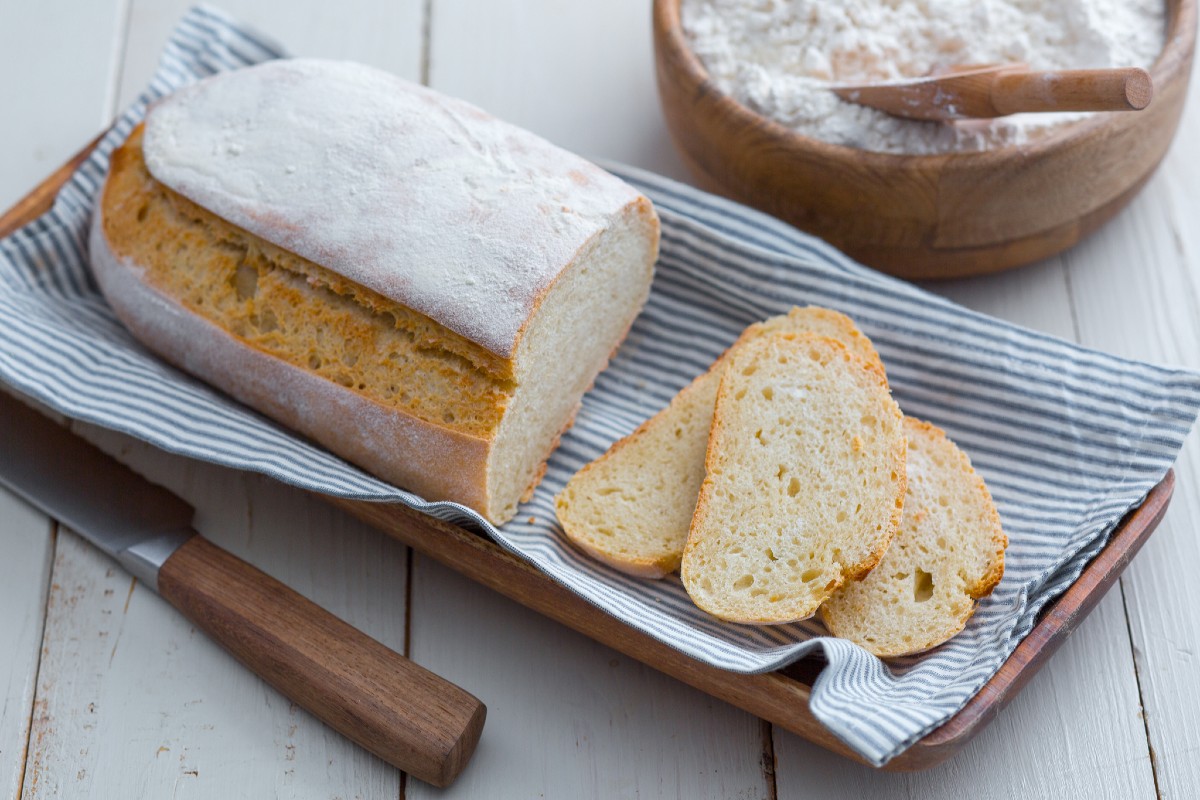Baguette with sourdough
- Average
- 1 h 30 min
- Kcal 485

Sourdough bread is such a classic. I mean, it’s a staple in Italian kitchens that shows how a few basic ingredients—like flour, water and patience—can create something really really special. Across Italy, many folks rely on a sourdough starter (or "lievito madre") instead of commercial yeast. Why? It adds a unique flavor and texture. This natural leavening gives the bread a slightly tangy aroma, a rustic feel, and a texture that's both crispy on the outside and soft on the inside. No need for fancy tools—just your hands, some simple ingredients, and time to let it rise. Pretty simple, right?
The real magic? It's in the giri di pieghe—the gentle hand folds and long rests that help the dough develop its special open crumb. In the end, you get artisan bread that’s way more interesting than most store-bought loaves. With sourdough bread, you'll find it stays moist for days and is much easier to digest than bread made with regular yeast. This is thanks to the longer fermentation process, which breaks down gluten and enhances the deep, golden color in the crust.
Italians have their own twists—some add semolina for a heartier bite, while others mix in herbs or seeds like pumpkin for extra flavor. Once you master the basic sourdough recipe, it's easy to branch out into thyme bread, baguettes, or even pizza dough using your sourdough starter. And listen, baking at home with natural leavening is super rewarding. The amazing smell filling your kitchen, and there's something special about slicing into bread you made yourself.
After a few tries, you might find yourself skipping the bakery because nothing beats the sweet, homey taste of real homemade sourdough. Plus, sharing a loaf with friends or family feels really good, especially knowing it came from your own hands. Whether you're in a bustling city or a quiet village, the tradition of making sourdough is a beautiful part of Italian life that brings warmth and joy to any home. For sure.
You might also like:

To prepare bread with sourdough starter, start with the dough. Pour the all-purpose flour and semolina into a bowl 1, add the malt 2, and slowly pour in the room temperature water while beginning to knead with your hands 3.

When the water is absorbed, add the sourdough starter, refreshed the day before and in any case at least 5 hours prior 4. Continue to knead. Add the oil 5 and salt 6.

Work again with your hands 7 until you get a homogeneous mixture. Cover with a cloth and let rest for 15-20 minutes. Now make the first round of folds. Take a piece of the dough, lift it gently, and bring it toward the center 8. Rotate the bowl 9 and repeat this operation. Continue in this way until you have picked up all the outer pieces of the dough, having completely rotated the bowl.

Cover with a cloth 10 and let rest for 15-20 minutes. Repeat these operations 3 more times 11, making 4 rounds of folds. You will notice that the dough becomes very smooth. Cover with plastic wrap 12 and let rise for 3 hours at room temperature.

It might take more or less time depending on the temperature; you will need to verify that the dough has doubled 13. At this point, place a cloth inside a bread basket 9 inches at the base and 12 inches on the surface. Dust with rice flour (or always semolina) 14 and set aside. Transfer the dough to the work surface 15.

Flatten it slightly to form a disc 16. Then make a three-fold, bringing one side of the dough towards the center first 16 and then do the same with the other 17. Pinch gently to adhere the dough and rotate it so the seam goes downward 18.

Stretch it gently to form a loaf 19. Then transfer it to the bread basket, this time placing the opening upward 20. Cover with the cloth 21 and let rise for another 2-3 hours.

When it has doubled in volume 22, transfer it to a baking sheet dusted with semolina 23. Gently remove any excess rice flour 34

and with a sharp blade, make a lengthwise cut along the entire length of the bread 25. At this point, bake the bread in a preheated oven at 437°F in static mode, add 10 ice cubes to the bottom of the oven, which when melted will release the right humidity, and bake for 20 minutes. Then switch to ventilated mode and bake the bread for another 10 minutes. Remove then the sourdough bread 26, transfer it to a rack and let it cool before serving 27.